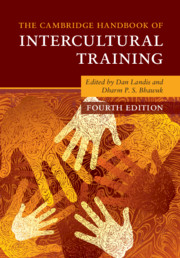Book contents
- The Cambridge Handbook of Intercultural Training
- Reviews
- The Cambridge Handbook of Intercultural Training
- Copyright page
- Dedication
- Frontispiece
- Contents
- Figures
- Tables
- Editors and Contributors
- Foreword
- Preface
- 1 Introduction and Theoretical Framework
- Part I Theoretical Foundations of Intercultural Training
- Part II Practice of Intercultural Training
- 10 International Initiatives in K–12 and Higher Education
- 11 The Triad Training Model in Counseling, Cultural Diversity, and Intercultural Training
- 12 Multicultural Counseling Training and Intercultural Training
- 13 Training for Cross-Cultural Competence in the United States Military
- 14 Developing Intercultural Competency Training in Global Organizations
- Part III Indigenous Psychology and Intercultural Training
- Part IV New Interdisciplinary Approaches to Intercultural Training
- Part V Summing Up
- Index
- References
13 - Training for Cross-Cultural Competence in the United States Military
from Part II - Practice of Intercultural Training
Published online by Cambridge University Press: 18 September 2020
- The Cambridge Handbook of Intercultural Training
- Reviews
- The Cambridge Handbook of Intercultural Training
- Copyright page
- Dedication
- Frontispiece
- Contents
- Figures
- Tables
- Editors and Contributors
- Foreword
- Preface
- 1 Introduction and Theoretical Framework
- Part I Theoretical Foundations of Intercultural Training
- Part II Practice of Intercultural Training
- 10 International Initiatives in K–12 and Higher Education
- 11 The Triad Training Model in Counseling, Cultural Diversity, and Intercultural Training
- 12 Multicultural Counseling Training and Intercultural Training
- 13 Training for Cross-Cultural Competence in the United States Military
- 14 Developing Intercultural Competency Training in Global Organizations
- Part III Indigenous Psychology and Intercultural Training
- Part IV New Interdisciplinary Approaches to Intercultural Training
- Part V Summing Up
- Index
- References
Summary
The present chapter presents a recent historical description of the implementation of cross-cultural competence (3C) training programs throughout the United States (US) military. Training for 3C in the military aims at increasing foreign cultural understanding and providing behavioral strategies necessary to improve interactions in a foreign operational environment or with people of different national backgrounds. The importance of 3C was highlighted through a DoD Strategic Plan and an active body of basic and applied research throughout the DoD from 2007 to 2014. However, by 2018, its strategic value waned, except for a few activities within the Marines and US Air Force. Some of the challenges 3C training programs experienced were: (1) limited funding to conduct training evaluations, (2) balancing a need for culture-specific training for immediate deployment vs. culture-general training for having a military force at the ready for "any-time" deployment, and (3) inconsistent language to operationalize “culture” across the forces. After a review of US military 3C training programs from mid 2000s, this chapter concludes with propositions for stimulating a demand signal and furthering valid evaluation research on the effectiveness of 3C training.
Keywords
- Type
- Chapter
- Information
- The Cambridge Handbook of Intercultural Training , pp. 440 - 474Publisher: Cambridge University PressPrint publication year: 2020
References
- 1
- Cited by



